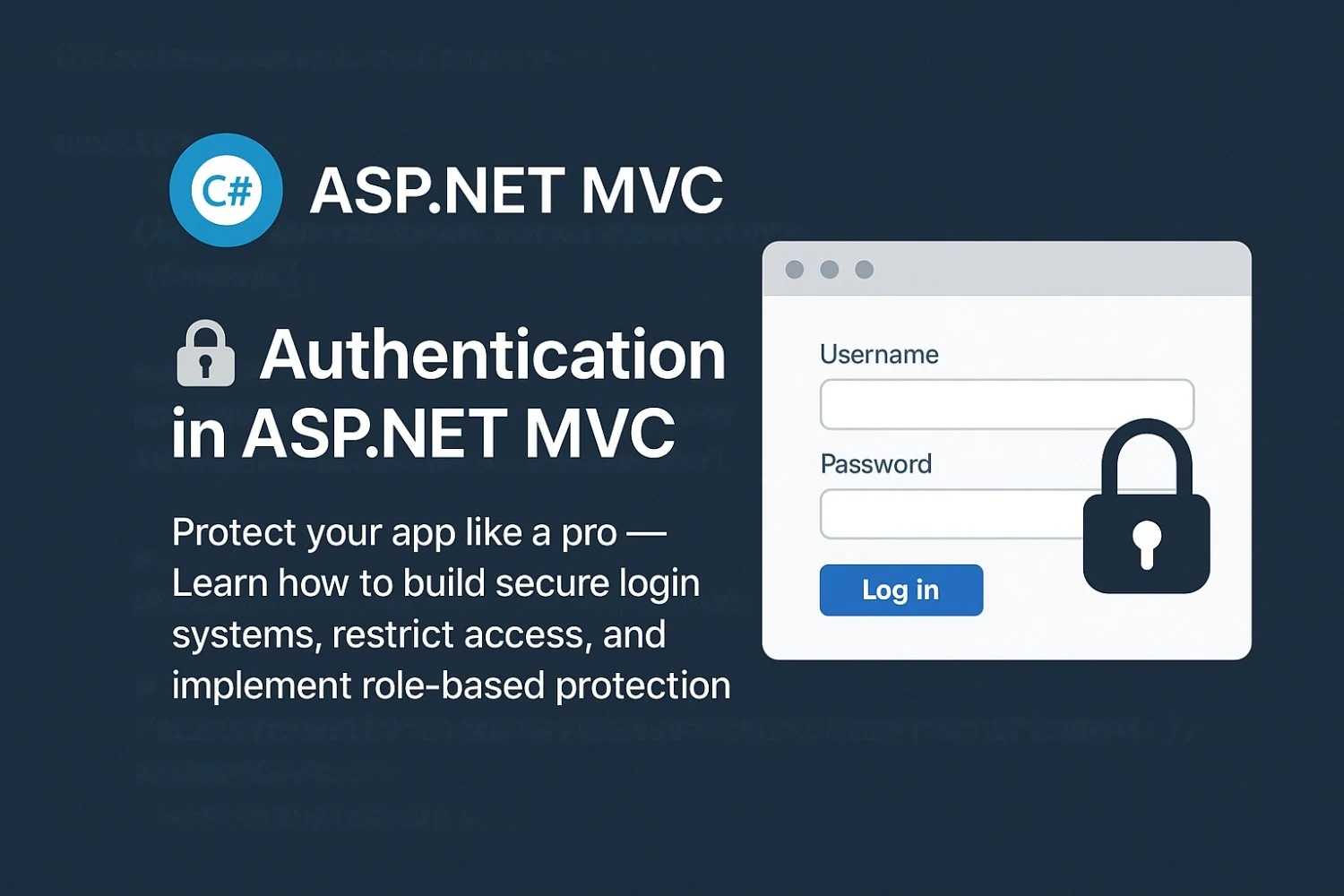Authentication in ASP.NET MVC allows you to identify and verify users before granting access to protected parts of the application. Here's a high-level overview of how authentication works in ASP.NET MVC (non-Core) and how to implement it.
✅ Types of Authentication in ASP.NET MVC
- Forms Authentication (Traditional)
- Windows Authentication
- OAuth / External Login (Google, Facebook, etc.)
- Token-Based Authentication (JWT, often with Web API)
For most web apps, Forms Authentication is commonly used.
🔐 1. Forms Authentication (with Login Page)
✅ Steps:
1. Enable Forms Authentication in Web.config:
<configuration>
<system.web>
<authentication mode="Forms">
<forms loginUrl="~/Account/Login" timeout="30" />
</authentication>
<authorization>
<deny users="?" /> <!-- Deny anonymous users -->
</authorization>
</system.web>
</configuration>
2. Create Login View + Controller Logic:
Model:
public class LoginViewModel{
public string Username { get; set; }
public string Password { get; set; }
}
Controller:
public class AccountController : Controller{
public ActionResult Login() => View();
[HttpPost]
public ActionResult Login(LoginViewModel model)
{
if (IsValidUser(model.Username, model.Password))
{
FormsAuthentication.SetAuthCookie(model.Username, false);
return RedirectToAction("Index", "Home");
}
ModelState.AddModelError("", "Invalid login attempt.");
return View(model);
}
public ActionResult Logout()
{
FormsAuthentication.SignOut();
return RedirectToAction("Login", "Account");
}
private bool IsValidUser(string username, string password)
{
// Replace with DB check or identity logic
return username == "admin" && password == "1234";
}
}
View (Login.cshtml):
@model YourApp.Models.LoginViewModel
@using (Html.BeginForm()) {
<label>Username</label>
@Html.TextBoxFor(m => m.Username)
<label>Password</label>
@Html.PasswordFor(m => m.Password)
<button type="submit">Login</button>
}
🔐 2. Protecting Actions with [Authorize]
Use this to restrict access:
[Authorize]public ActionResult SecurePage()
{
return View();
}
To allow anonymous access:
[AllowAnonymous]
public ActionResult Login() => View();
🔄 Redirect on Session Expiry
ASP.NET will automatically redirect to the login page if the user is not authenticated, based on the loginUrl in Web.config.
🔑 Alternative: ASP.NET Identity (for more advanced use)
If you're using ASP.NET Identity (like with Visual Studio templates), authentication becomes more powerful with roles, claims, password recovery, etc.
✅ Goal: Authentication in ASP.NET MVC using Forms Authentication + SQL Server
🧱 Structure Overview
-
✅ SQL Server with
Userstable - ✅ ASP.NET MVC Login screen
- ✅ Authenticate and store the cookie using
FormsAuthentication - ✅ Restrict access using
[Authorize]
🗃️ 1. SQL Server Table (Users)
CREATE TABLE Users (
Id INT PRIMARY KEY IDENTITY,
Username NVARCHAR(100) NOT NULL,
Password NVARCHAR(100) NOT NULL
);
Add a test user:
INSERT INTO Users (Username, Password)
VALUES ('admin', '1234'); -- store hashed passwords in production!
🔌 2. Set Up Your MVC Project
- Create an ASP.NET MVC Project (Visual Studio → New Project → ASP.NET MVC).
- Add an ADO.NET Entity Data Model to connect to your
Userstable.
🧑💻 3. Create Login Model
public class LoginViewModel
{
[Required]
public string Username { get; set; }
[Required]
[DataType(DataType.Password)]
public string Password { get; set; }
}
🎮 4. Create Account Controller
public class AccountController : Controller
{
private YourDbContext db = new YourDbContext(); // Replace with your EF context
public ActionResult Login() => View();
[HttpPost]
public ActionResult Login(LoginViewModel model)
{
if (ModelState.IsValid)
{
var user = db.Users.FirstOrDefault(u => u.Username == model.Username && u.Password == model.Password);
if (user != null)
{
FormsAuthentication.SetAuthCookie(user.Username, false);
return RedirectToAction("Index", "Home");
}
ModelState.AddModelError("", "Invalid username or password.");
}
return View(model);
}
public ActionResult Logout()
{
FormsAuthentication.SignOut();
return RedirectToAction("Login", "Account");
}
}
🧾 5. View (Login.cshtml)
@model YourNamespace.Models.LoginViewModel
@using (Html.BeginForm()) {
@Html.LabelFor(m => m.Username)
@Html.TextBoxFor(m => m.Username)
@Html.ValidationMessageFor(m => m.Username)
@Html.LabelFor(m => m.Password)
@Html.PasswordFor(m => m.Password)
@Html.ValidationMessageFor(m => m.Password)
<button type="submit">Login</button>
}
🔐 6. Protect Pages Using [Authorize]
[Authorize]
public class HomeController : Controller
{
public ActionResult Index()
{
return View();
}
}
⚙️ 7. Web.config Configuration
<system.web>
<authentication mode="Forms">
<forms loginUrl="~/Account/Login" timeout="30" />
</authentication>
<authorization>
<deny users="?" />
</authorization>
</system.web>
✅ 8. Done! Now:
- Visit any secure page → redirected to Login
- Enter correct credentials from DB → redirected to Home
- Click Logout → session removed
🔒 Security Note
- In real applications, store passwords as hashes (e.g., SHA256 or bcrypt).
- You can use ASP.NET Identity for more secure systems with role management, password hashing, and email verification.
⚠️ Without Authentication
- Anyone can change your data
- No audit trail of who did what
- Can’t protect sensitive features
- Security threats (unauthorized access, data leaks)


Post a Comment